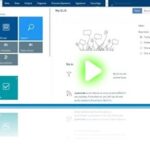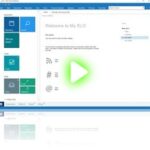ELO allows document management and process automation through workflow

Our goal is to go beyond digitalization and preservation of documents. It is to increase the efficiency of business processes through completely automating the management of information arriving from any source.
The ELO solution allow to to reach the goal.
The strengths of the ELO solution are:
Total integration of information whatever its origin (ERP, CRM, … paper documents)
The search for information in the company takes place by switching from one application to another or, in the case of documents coming from third parties, in files on network servers, in email servers or in dossiers of paper documents. ELO allows all information to be integrated thanks to its interfacing capabilities between applications and scanners.
The company systems can be interfaced through different modules (ELO BLP connects ERP, CRM, CAD for a complete integration) intercepting the generation of documents. ELO intercepts the document, classifies it by reading the data in the application and stores it according to the given rules.
ELO is integrated in the Office tools (Outlook, Word, Excel, PowerPoint) so that the documents generated or received there can be immediately classified and stored with different levels of automation. More sophisticated integrations and automation can be created with Microsoft Exchange or IBM Lotus Notes for e-mail.
Any paper document can be directly dematerialized, classified and filed through scanners. ELO commands scanners on the network both in single page and multi page mode. The OCR feature facilitates the indexing of any document containing texts. Additional modules, such as ELO DocXtractor, allow you to automatically manage both the indexing and the storage of data. Key data can be verified and uploaded in the company management systems as well as can initiate workflows consistent with the content of the document.
ELO offers a platform that can be transparently and efficiently integrated into any IT environment.
Integration of the business processes through the document management workflow
The management of control and approval processes through the IT system has always been a hoped for goal, but never achieved. This is because not all information are manageable in a single system. ELO through its workflow system, which manages the document control processes, allows to achieve the goal.
An easy drawing of the process, linked to the control and approval of a document, can be defined at different levels:
Standard workflows: different flow charts can be designed to define standard business processes. These procedures can be activated automatically when archiving or receiving a specific type of document or manually initiated by the user when necessary.
Ad hoc workflow: a simple sequence of transmissions can be defined by the user on specific cases.
Reminder: a document can be notified or solicited to another user or group of users.
Special Workflows with custom forms can be created for internal authorization processes not treated in the management system (leave / vacation requests, expense reports, returns management, …). In this type of workflow it is possible to draw forms for the selection and input of data, eliminating paper or spreadsheet forms.
The management system of authorizations for individual users, for functional groups and for geographical groups allows complete control of access to individual information and workflow task even in very complex organization structures
Target: full dematerialization
The objective of processing all information, whether generated internally or received from outside, in digital form is obtained by integrating both the qualified digital signature and the advanced electronic signature (FEA) or graphometric signature. The need for graphic signature was the last obstacle to the complete dematerialization. The goal is achieved in ELO with the FSC integrations with various types of electronic signatures.
Graphometric signature: it can be applied to the single document in the archive or be requested in one or more activities of the document process flow (see workflow). The integrated signature collects and incorporates the bio-metric data necessary for full legal validity. The signature can be associated with a strong certificate in the detector of the handwritten signature for people external to the organization. It can be of a corporate certificate for storing handwritten signatures of internal staff or registered customers.
Qualified digital signature: it can be applied to a single document or to packages of documents. The document package can be defined automatically according to rules defined in ELO and the application of the signature performed on a time schedule.
Remote digital signature on HSM (Hardware Security Module) server: it does not require having a local certificate but requires connection to the Internet. It can also be requested for a single document or for a block of documents.
Time Stamp: it is requested from a CA (Certification Authority) and allows to record in the document or in the package of documents date and time certified by the CA; it requires connection to the Internet and the purchase of stamps from the selected CA.
The Fiscal Conservation becomes simple
On-site storage: in this case the archive, the hardware infrastructure and the internal process control procedures are implemented within the Company. ELO allows you to create the packages required by the norms, sign them and mark them according to the rules defined in the conservation manuals and ensure they cannot be modified.
Storage in the Cloud: in this case, the storage according to the law is ensured by the service provider, which will provide HW infrastructure and the conservation process. ELO will provide, through the channel defined by the provider, the packages to be archived.
The high level of access control to documents and the integration of digital signatures have made it possible to create in ELO a long-term conservation module, ensuring strict standards of authenticity, integrity, reliability, readability and availability, as defined in the Italian legislation denominated: Conservazione a Norma.
Automatic or manual execution of the procedure
Conservazione a Norma
The generation of the document packages required by the procedure is the first step of the conservation process. The selection and preparation of the documents to be archived will allow to implement alternatively:
Conservation on site, creating a specific conservation archive in ELO
Storage on a Cloud service, with an external provider
The procedure can be started manually or automatically, if programmed in the ELO scheduler. The periodicity of execution and the relative advances can be easily customized by document typology.
Preparation and control of documents
A special workflow selects the documents that are due for storage. The process generates exceptions for any anomaly found in the documents (file format, invalid signatures, interrupted numbering sequence, …), launching specific exception handling workflows, which will be addressed to the pertinent offices based on the type of document exception.
Packages successfully completed can be signed or not, depending on what is required in the conservation manual. If you use a cloud storage service, the process ends with the sending of the packages and the related documents to the service provider’s address.
Signature e conservation
The procedure consists of a special workflow, which collects the documents selected for storage and creates the related packages according to the rules provided by the norms.
The closure of the conservation packages involves the application of the digital signature and the time stamp and the storage of a non-modifiable copy in the conservation archive.
Extraction of documents for consultation and control
On each request for exhibition or copy it is possible to create collection queries and generate the requested package, which can be published in display to authorized users or be copied in a special device according to the specifications contained in the request.




